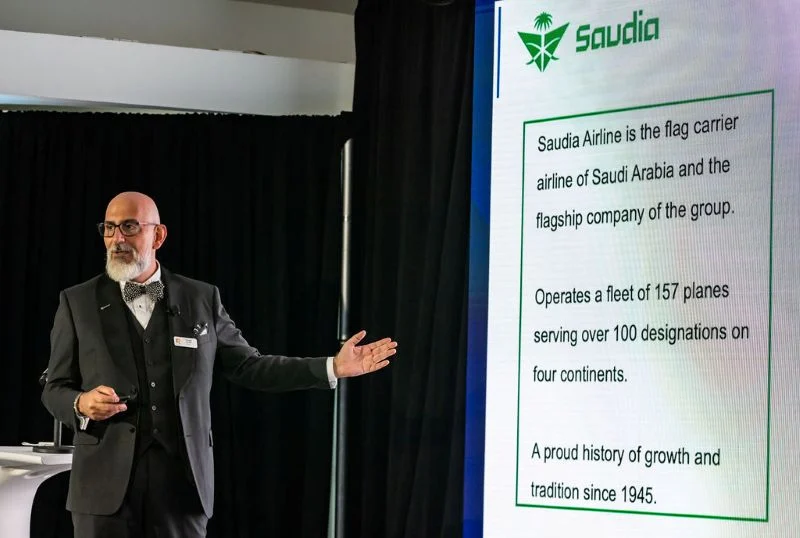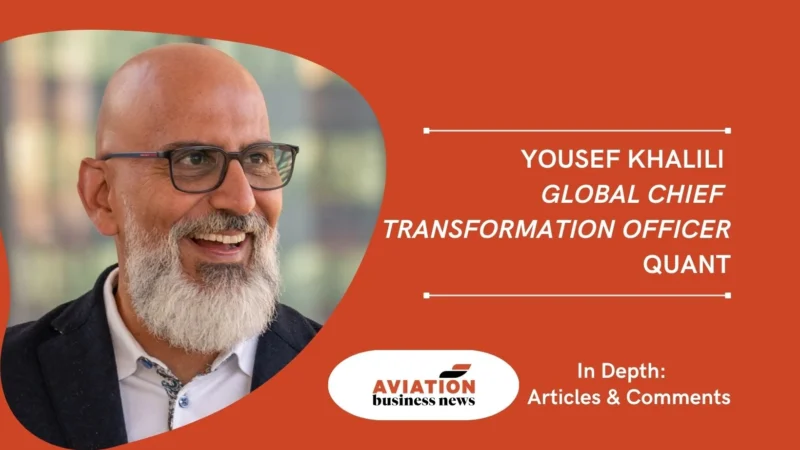Following his presentation at TRLEngage last week where shared the stage with Saudia Airlines, Yousef Khalili, global chief transformation officer at technology developer Quant, sets out a blueprint for aviation’s Agentic AI future
Air travel has always been one of the most complicated industries in the world.
From the booking of a ticket to final destination, every journey involves multiple systems, providers and checkpoints.
For years, airlines have sought to use digital tools to enhance the experience, but most of the efforts have been limited to dumb chatbots, self-service applications or automated FAQs.
Today, the conversation has moved on to Agentic AI. Unlike generative AI which generates text or answers questions at best, agentic AI is meant to act.
It makes decisions, performs tasks across systems and coordinates across multiple parties in real-time.
For airlines, that paves the way to a new type of passenger experience – one that could eventually be seamlessly woven across the journey, before, during and after the flight.
But let’s get this straight: no airline is operating entirely agentic platforms today.
What we have are nascent efforts: contact centres experimenting with end-to-end problem solving ‘conversational’ agents; mobile apps that show signs of proactive rebooking; or social media bots with the ability to manage a complaint with more context.
These are important steps, but they are not quite what aviation is going to need: a holistic, integrated agentic layer.

Passenger-Facing Agents
The first frontier is passenger-facing – what we can call B2C agents. These include:
- Contact centre agents that are moving beyond scripted bots. Instead of simply answering questions, they can re-book flights, give refunds or automatically process upgrades.
- Mobile app or website agents which behave like personal travel assistants – proactively recommending a later flight in case a meeting overruns, or booking a lounge if a layover is getting longer.
- Social media agents able to resolve disruption directly on social media platforms where passengers are already complaining, such as when they have to rebook or get compensation.
Already, several leading global carriers are experimenting with agentic approaches, not just in terms of chatbots, but also in terms of early digital workers, capable of actually resolving requests, in a variety of contact centres and digital platforms.
Early results indicate increased resolution rates, reduced times to handle and increased loyalty metrics. This trend is supported by our own work with a leading global airline.
Rather than discussing whether agentic platforms will ever take off in the industry, the hot topic is now how quickly they may materialise and how extensively they can be scaled.
The fake “One-Agent” GPT-based phenomenon
It is important to distinguish between hype and reality. Many solutions in the market today are branded as “agentic”, where really they are not.
What they tend to deliver is a single generative AI layer – a chatbot linked to a few APIs – that is able to answer questions or do one thing at a time.
That is not agentic AI. True agentic platforms are comprised of multiple specialised agents that act in concert with each other and exchange context to perform coordinated actions across different systems without being constantly prompted by a human.
The difference is fundamental in the case of aviation. One generative layer may inform a passenger that his or her flight is running late.
A real network of agents could go further though by rebooking the passenger on an alternate, adjusting gate assignments with the airport, re-routing baggage, notifying catering and issue loyalty compensation – all in sequence and automatically.
Airlines should be wary of “agentic in name only” solutions that address one visible issue and don’t scale in the complexity of operations.
Operational & Collaborative Agents
The bigger opportunity – and the bigger complexity – lies in B2B agents. Those are behind-the-scenes digital workers connecting airlines, airports, ground handlers, and regulators.
This is where aviation is still using protocols that date back half a century.
IATA Type B messages for instance – fixed-width teletype message formats – are still in use to transport important information such as gate allocation, baggage status and passenger manifest.
Many airports transfer them as “fax-over-email”, leaving staff to manually re-key updates into systems.
Some hubs, such as Heathrow and Frankfurt, are moving towards Airport Collaborative Decision-Making (A-CDM), in which milestones such as Target Off-Block Time (TOBT) are aligned.
Others are testing AIDX, which is an XML standard for flight and gate data. But adoption is uneven and the result is that airlines and airports are rarely on the same page digitally.
B2B agentic AI may change that.
Instead of waiting for the airline staff to reconcile and bring outdated messages into order, digital agents could consume Type B or AIDX feeds, validate them against flight operations data and then trigger co-ordinated actions such as updating passenger apps, reissuing boarding passes, or simply pushing new stand allocations to crew tablets and display boards.
In disruption scenarios, B2B agents could act as the glue to unite airlines and airports – automating processes such as slot allocation, gate reallocation, and ensuring that knock-on delays are kept to a minimum.
In baggage, scan findings could be reconciled under IATA Resolution 753 whereby agents could proactively notify passengers, and even initiate compensation policies.
Cross-Department Agents: Within The Airline Group
The next horizon is within the airline enterprise itself.
An airline is not merely a flying service – it is a group of businesses in one: flight operations, maintenance and engineering (MRO), cargo, catering, ground services, crew housing and staff transport.
On top of that, like any large corporation it has to deal with HR, finance, marketing, loyalty, legal and procurement.
Each function is run on different systems and processes which are often stitched together with manual workarounds.
Here, an enabler is cross-department agentic AI:
- In the area of Flight Operations, agents are able to coordinate crew rosters, aircraft readiness and slot management in real-time – with links with air traffic updates, A-CDM milestones and even weather data to minimise disruption.
- In MRO and Engineering, an agent would be able to monitor, to schedule maintenance, or to coordinate the delivery of parts to aircraft – and to automatically update the operations control if the readiness was delayed.
- In the case of cargo, an agent could balance the belly capacity across flights, prioritise shipments that yield the highest profit and coordinate with their ground handlers so that they can ensure they are loaded accurately.
- In catering, agents are able to compromise on last-minute upgrades and meal counts, reducing waste and improving service.
- In staff housing and transport, agents would be able to match crew rosters with available accommodation and buses in congested airports or expensive layover cities.
On the corporate side, there could be digital employees to handle the onboarding of new employees in HR, check compliance of crew training, reconcile vendor invoices in finance, or monitor regulatory filings in legal.
At a group level, the opportunity becomes even greater.
The airline’s holding company – AKA the group – can have agents share parts inventory across subsidiaries, dynamically re-allocate cargo capacity or consolidate finance and reporting across jurisdictions.
This kind of cross-company orchestration is often invisible to passengers, but is directly influential in regards to operational resiliency, costs and ultimately passenger experience.
Towards the Development of an Industry Blueprint
If the next ten years, the aviation industry is going to be dominated by agentic AI, and it will require more than call centre pilots.
It will require a blueprint – a concerted effort among airlines, airports and regulators.
Three priorities stand out:
- Understand the difference between B2C and B2B agents:
- Passenger-facing agents will create a sense of loyalty and visible differentiation.
- Operational agents will unleash the resilience and coordination that makes the visible experience possible.
- Expand to inter-departmental and teamwork:
- Agentic AI should not be regarded by airlines as only a passenger tool, but also as a backbone for flight operations, MRO, cargo, catering, and corporate functions.
- Raise the bar for interoperability:
- IATA has been progressive with AIDX and A-CDM but adoption needs to speed up. Without shared frameworks, each airline is at risk of building siloed agents that cannot work together.
- IATA, ACI and ICAO could have a convening role in defining protocols so that agents from all over the airlines, airports and even corporate functions are able to communicate.
Collaboration is the Key to Future-Proofing the Agentic model
Airlines are confronted with cycles of disruption – from pandemics to fuel shocks.
Resilience is not just an issue at the individual carrier level, but also in the ecosystem to better future-proof the passenger experience.
Agentic AI provides that possibility.
Imagine a future where a B2C agent will rebook a missed connection instantly, whereas a B2B agent negotiates a new slot with the airport through A-CDM and an update of the crew roster, and then, a cross-department agent makes sure that flight ops, catering, baggage and crew transport are aligned automatically.
Handled this way, agentic AI is not about replacing people but about empowering staff as well as passengers.
It is about creating a coherent layer of intelligence that will finally bring together the quilt of aviation.
